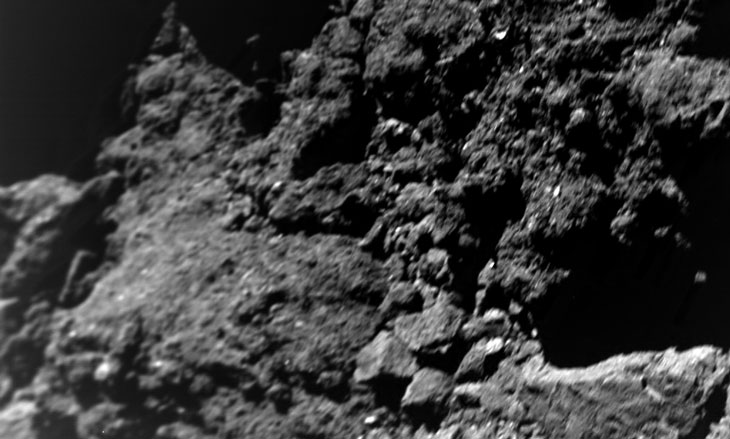Ryugu is a neat freak. The surface of the small, near-Earth asteroid is surprisingly free of dust, observations from Germany’s MASCOT lander show.
The asteroid, thought to have formed from the breakup of a larger body around 700 million years ago, has no atmosphere to protect it from interplanetary dust streaming through the solar system (SN: 4/27/19, p. 4). These miniature missiles pummel exposed space rocks at high speed, breaking down their surfaces into thin layers of dust and dirt, such as those found on the moon and the asteroid Vesta.
But when MASCOT bounced across Ryugu in October 2018 (SN Online: 9/24/18), the lander took high-resolution photos that show no sign of any dust-sized particles, down to a resolution of about 100 micrometers, about the thickness of a sheet of paper, researchers report in the Aug. 23 Science.
“After a few tens of millions of years, you should have dust on the surface,” says planetary scientist Ralf Jaumann of the German Aerospace Center in Berlin. “If it’s not there, you should have some kind of physical, geological processes which clean up these bodies.”

Ryugu could hide its dust in larger, porous rocks or deep in its interior, Jaumann and colleagues say. Shaking due to a meteorite impact may shuffle the particles into bigger surface rocks or down through small surface cracks to the asteroid’s center and out of sight, the way small nuts end up at the bottom of a cup of trail mix.
Or Ryugu could spray dust into space when sunlight heats patches of trapped ice and releases volatile gases. A similar asteroid, Bennu, seems to spew plumes of small rocks into space, according to NASA’s OSIRIS-REx spacecraft (SN: 4/13/19, p. 10). But Jaumann thinks that explanation is less likely for Ryugu. Observations from the Japanese Hayabusa2 craft, which has been orbiting Ryugu since June 2018 and brought MASCOT along, suggest that Ryugu has less water in its minerals than Bennu (SN: 1/19/19, p. 6).
There’s another possible explanation for Bennu’s dust sprays, says OSIRIS-REx principal investigator Dante Lauretta of the University of Arizona. He thinks frequent temperature changes on Bennu’s surface as the different sides of the asteroid rotate in and out of sunlight could make the asteroid’s larger rocks fracture like a snapped cracker, spraying crumbs into space.
If something similar happens on Ryugu, “then Ryugu should also be ejecting particles,” he says. Hayabusa2 may just not be in the right position to see the sprays. “It would be very cool if we saw it.”
But snapping rocks might create more dust, not less, he notes. An answer to the mystery may not come until after Hayabusa2 returns to Earth with samples of Ryugu’s surface and subsurface in late 2020 (SN: 8/17/19, p. 14).
https://www.sciencenews.org/article/asteroid-ryugu-surface-has-surprisingly-little-dust
2019-08-22 18:00:00Z
52780360851518
Bagikan Berita Ini















0 Response to "For an asteroid, Ryugu has surprisingly little dust on its surface - Science News"
Post a Comment